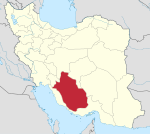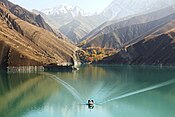Sivand Dam
30°08′20″N53°05′01″E/ 30.13889°N 53.08361°E Sivand Dam(Persian:سد سیوند) is adambuilt in 2007 inFars Province,Iran.[1]Named after the nearby town ofSivandlocated northwest ofShiraz,it was the center of worldwide concern because of the flooding it would cause in historical andarchaeologicallyrich areas ofAncient Persiaand possible harm it may cause to the nearbyUNESCOWorld Heritage SitesofPersepolisandPasargadae.[2]
Planning and history
[edit]The Iranian government planned Sivand Dam for over 10 years, with a location on the Polvar River in theTangeh Bolaghi(Bolaghi Gorge) in between the ruins of Persepolis and Pasargadae. Intended to allowirrigationin the arid region, the planning and initial site construction began in 1992, then was stopped for further planning and was reactivated in 2003.
For the first decade, much of the planning was not made public; Iran's ownIranian Cultural Heritage Organization(ICHO) was not aware of total area of flooding until 2003. When the intentions for the dam were made public, international concern was raised regarding damage to any archaeological sites, particularly the two World Heritage Sites. Rumors spread that the dam would place the two ruins under water, spurring outcry and petitions of concerned experts and individuals. Scientists with the dam project dismissed the rumors outright, and Iranian officials pointed some blame for the rumors on the political opposition parties from outside Iran. Iranian Ministry of Energy studies have placed the furthest reaches of the lake approximately 7 kilometers to south of the plain of Murqab; that is 9 kilometers from Pasargadae and more than 70 kilometers from Persepolis.
However, Iranian officials from the Ministry of Energy and ICHO did acknowledge that the lake will flood 130 Persian archeological sites and invited international teams to help excavate the area before construction commenced. In 2004, theUnited Nationsissued an urgent international appeal for archaeologists to join the domestic effort to unearth and record what they could before the flooding. Teams fromGermany,France,Italy,Japan,Poland,and theUnited Statesresponded to the request for help.[2]
One consequence of the dam's construction was an opportunity for extensive archaeological work in a historically rich area in a short amount of time. The oldest sites the international teams found were caves inhabited about 7,000 years ago.[citation needed]The archaeologists uncovered a narrow 9-mile dirt road believed to be the Royal Passage of theAchaemenids,connecting the two ancient cities, that was in use until the 18th century.
The archaeological work caused the construction schedule of Sivand Dam to be pushed back. The area was originally supposed to be flooded by end of February 2006, but the discovery of an Achaemenid-era village and cemetery caused it to be delayed.
Potential effects on Pasargadae
[edit]Besides the certain flooding of 130 archaeological sites, larger concern has been levied at the dam's effect on nearby World Heritage Sites, particularly Pasargadae, an ancient capital of thePersian Empirebuilt byCyrus the Greatand the site of his tomb.
Experts involved with planning the dam deny this claim, noting that the site is well above and away from the eventual waterline. However, it is unknown how the dampness caused by the dam will affect the ruins. Archaeologists and scientists agree that the rise in humidity from the new lake will speed up the destruction of Pasargadae to some degree.[2]Although no preliminary environmental research has been carried out to assess the effects of humidity upon the constructions at Pasargadae, the Ministry of Energy believes it could be compensated by controlling the water level of the dam reservoir.
In 2010, studies of the Pasargadae showed thatgroundwaterlevels in the area had risen as a result of the dam and lake. The higher groundwater levels and increased humidity were said to be directly affecting foundation failures and the forming of newer cracks in walls and platforms throughout the ruins.[3]
Completion
[edit]Sivand Dam was completed in 2007,[1]but the height of the lake behind it was delimited so that it would not harm the site of Cyrus the Great Mausoleum. Dr. Shahriar Adl was active in preserving the site.[4]
See also
[edit]References
[edit]- ^abCyrus the Great tomb needs constant monitoring of moistureTehran Times, 6 August 2008
- ^abc"Minerva:: News".minervamagazine.Archived fromthe originalon 2003-02-03.
- ^Archaeology News Network, December 2010
- ^Lamentable Loss: Dr. Shahriar Adl died on June 21 2015
- Date of Sivand Dam Inundation Not Yet Agreed Upon,Cultural Heritage News Agency,29 May 2006,Accessed Sept. 15, 2006.
- Sivand Dam Waits for Excavations to be Finished,Cultural Heritage News Agency, 26 February 2006,Accessed Sept. 15, 2006.
- Sivand Dam’s Inundation Postponed for 6 Months,Cultural Heritage News Agency, 29 November 2005,Accessed Sept. 15, 2006.
- Nazila Fathi,A Rush to Excavate Ancient Iranian Sites,The New York Times,November 27, 2005; also accessible in fullhere.
- Ali Mousavi,Cyrus can rest in peace: Pasargadae and rumors about the dangers of Sivand Dam,Iranian, September 16, 2005
- Pasargadae Will Never Drown,Cultural Heritage News Agency, 12 September 2005,Accessed Sept. 15, 2006.
- Rémy Boucharlat,News from Pasargadae,ANE: DISCUSSION LIST FOR THE STUDY OF THE ANCIENT NEAR EAST, University of Chicago listserv, 29 Dec 2004,Accessed Sept. 15, 2006(Boucharlat is now the head of the French archaeological team in the region).
- Ancient Pasargadae threatened by construction of dam,Mehr News Agency, 28 August 2004,Accessed Sept. 15, 2006
External links
[edit]- Deutsches Archäologisches Institut (German Archaeological Institute),Iran: Darre-ye Bolāghi(in English).
- Kamyar Abdi,Sensationalism vs. Rationalism.The Sivand Dam: political sensationalism vs. archaeological rationalism,September 12, 2005,Iranian.
- Ali Mousavi,Cyrus can rest in peace.Pasargadae and rumors about the dangers of Sivand Dam,September 16, 2005,Iranian.



